Modification of IPI Method for Extraction of Short-Term and Imminent OLR Anomalies and Case Study of Two Large Earthquakes
Abstract
1. Introduction
2. Data Sources and Preprocessing in This Study
3. Methods
RIPI = √2 R
RNClow = Q1 − 1.5·IQR
RNCup = Q3 + 1.5·IQR
4. Earthquake Case Studies
4.1. 2019-07-06 Ridgecrest Ms 6.9 Earthquake, USA
4.1.1. Study Area and Calculation Parameters
4.1.2. Results
4.2. 2021-05-21 Maduo Ms 7.4 Earthquake, China
4.2.1. Study Area and Calculation Parameters
4.2.2. Results
5. Conclusions and Discussion
Author Contributions
Funding
Data Availability Statement
Acknowledgments
Conflicts of Interest
References
- Rundle, J.B.; Klein, W.; Tiampo, K.; Gross, S. Linear pattern dynamics in nonlinear threshold systems. Phys. Rev. E 2000, 61, 2418–2431. [Google Scholar] [CrossRef]
- Rundle, J.B.; Klein, W.; Turcotte, D.L.; Malamud, B.D. Precursory seismic activation and critical-point phenomena. Pure Appl. Geophys. 2000, 157, 2165–2182. [Google Scholar] [CrossRef]
- Rundle, J.B.; Tiampo, K.F.; Klein, W.; Martins, J.S.S. Self-organization in leaky threshold systems: The influence of near-mean field dynamics and its implications for earthquakes, neurobiology, and forecasting. Proc. Natl. Acad. Sci. USA 2002, 99, 2514–2521. [Google Scholar] [CrossRef] [PubMed]
- Tiampo, K.F.; Rundle, J.B.; McGinnis, S.; Gross, S.J.; Klein, W. Mean-field threshold systems and phase dynamics: An application to earthquake fault systems. Europhys. Lett. 2002, 60, 481–488. [Google Scholar] [CrossRef]
- Holliday, J.R.; Nanjo, K.Z.; Tiampo, K.F.; Rundle, J.B.; Turcotte, D.L. Earthquake forecasting and its verification. Nonlinear Process. Geophys. 2005, 12, 965–977. [Google Scholar] [CrossRef]
- Holliday, J.R.; Rundle, J.B.; Tiampo, K.F.; Klein, W.; Donnellan, A. Systematic procedural and sensitivity analysis of the pattern informatics method for forecasting large (M > 5) earthquake events in southern California. Pure Appl. Geophys. 2006, 163, 2433–2454. [Google Scholar] [CrossRef]
- Holliday, J.; Rundle, J.; Tiampo, K.; Klein, W.; Donnellan, A. Modification of the pattern informatics method for forecasting large earthquake events using complex eigenfactors. Tectonophysics 2006, 413, 87–91. [Google Scholar] [CrossRef]
- Radan, M.Y.; Hamzehloo, H.; Peresan, A.; Zare, M.; Zafarani, H. Assessing performances of pattern informatics method: A retrospective analysis for Iran and Italy. Nat. Hazards 2013, 68, 855–881. [Google Scholar] [CrossRef]
- Zhang, Y.; Zhang, X.; Wu, Y.; Yin, X. Retrospective study on the predictability of pattern informatics to the Wenchuan M8.0 and Yutian M7.3 earthquakes. Pure Appl. Geophys. 2012, 170, 197–208. [Google Scholar] [CrossRef]
- Molchan, G.M. Earthquake prediction as a decision-making problem. Pure Appl. Geophys. 1997, 149, 233–247. [Google Scholar] [CrossRef]
- Chang, L.-Y.; Chen, C.-C.; Telesca, L.; Li, H.-C.; Cheong, S.A. Pattern informatics and the soup-of-groups model of earthquakes: A case study of Italian seismicity. Pure Appl. Geophys. 2020, 177, 4089–4096. [Google Scholar] [CrossRef]
- Wu, A.X.; Zhang, Y.X.; Zhou, Y.Z.; Zhang, X. On the spatial-temporal characteristics of ionospheric parameters before Wenchuan earthquake with the MPI method. Chin. J. Geophys. 2011, 54, 2445–2457. [Google Scholar]
- Maimaitusun, N. Application of PI Algorithm in Extracting Ionospheric Disturbance Anomalies from DEMETER Satellite Data. Master’s Thesis, Institute of Earthquake Forecasting, China Earthquake Administration, Beijing, China, 2012. (In Chinese). [Google Scholar]
- Xia, C.Y. In-depth Study on Extracting Ionospheric Disturbance Anomalies Using the Improved PI Method. Master’s Thesis, Institute of Earthquake Forecasting, China Earthquake Administration, Beijing, China, 2015. (In Chinese). [Google Scholar]
- Song, C. Retrospective Long-Term Prediction of Large Earthquakes Based on the PI Method. Master’s Thesis, Institute of Earthquake Forecasting, China Earthquake Administration, Beijing, China, 2017. (In Chinese). [Google Scholar]
- Tian, W.; Zhang, Y.; Ju, C.; Zhang, S.; Feng, M.; Liu, F. An Improved Pattern Informatics Method for Extracting Ionospheric Disturbances Related to Seismicity Based on CSES Data: A Case Study of the Mw 7.3 Maduo Earthquake. Authorea, 2023; Preprints. [Google Scholar]
- Gornyy, V.I.; Tronin, A.A.; Shilin, B.V.; Sal’man, A.G. Outgoing terrestrial infrared radiation as an indicator of seismic activity. Trans. USSR Acad. Sci. Earth Sci. Sect. 1988, 301, 5–7. [Google Scholar]
- Qiang, Z.J.; Kong, L.C.; Guo, M.H. Experimental Study on the Mechanism of Satellite Thermal Infrared Warming. Acta Seismol. Sin. 1997, 19, 87–91. (In Chinese) [Google Scholar]
- Qiang, Z.; Dian, C.; Li, L.; Xu, M.; Ge, F.; Liu, T.; Zhao, Y.; Guo, M. Abnormal Brightness Temperature in Satellite Thermal Infrared Images: A Short-Term Earthquake Precursor. Sci. China Ser. D Earth Sci. 1998, 42, 564–574. (In Chinese) [Google Scholar]
- Wu, L.; Cui, C.; Geng, N.; Wang, J. Remote sensing rock mechanics (RSRM) and associated experimental studies. Int. J. Rock Mech. Min. Sci. Géoméch. Abstr. 2000, 37, 879–888. [Google Scholar] [CrossRef]
- Freund, F.T. Rocks that crackle and sparkle and glow: Strange pre-earthquake phenomena. J. Sci. Explor. 2003, 17, 37–71. [Google Scholar]
- Sun, H.B.; Zhang, X.D. A Study on the Relationship Between Longwave Radiation and Earthquakes. Plateau Earthq. 1990, 2, 68–73. (In Chinese) [Google Scholar]
- Kang, C.L.; Chen, Z.W.; Chen, L.Z.; Wang, G. Analysis of Satellite Thermal Infrared Precursory Features of the Kunlunshan Kou West M8.1 Earthquake. Northwest. Seismol. J. 2003, 25, 12–15. (In Chinese) [Google Scholar]
- Ouzounov, D.; Liu, D.; Chunli, K.; Cervone, G.; Kafatos, M.; Taylor, P. Outgoing long wave radiation variability from IR satellite data prior to major earthquakes. Tectonophysics 2007, 431, 211–220. [Google Scholar] [CrossRef]
- Clarisse, L.; R’Honi, Y.; Coheur, P.-F.; Hurtmans, D.; Clerbaux, C. Thermal infrared nadir observations of 24 atmospheric gases. Geophys. Res. Lett. 2011, 38, 10. [Google Scholar] [CrossRef]
- Wan, Z. New refinements and validation of the collection-6 MODIS land-surface temperature/emissivity product. Remote Sens. Environ. 2014, 140, 36–45. [Google Scholar] [CrossRef]
- Eleftheriou, A.; Filizzola, C.; Genzano, N.; Lacava, T.; Lisi, M.; Paciello, R.; Pergola, N.; Vallianatos, F.; Tramutoli, V. Long-term RST analysis of anomalous TIR sequences in relation with earthquakes occurred in Greece in the period 2004–2013. Pure Appl. Geophys. 2015, 173, 285–303. [Google Scholar] [CrossRef]
- Bhardwaj, A.; Singh, S.; Sam, L.; Bhardwaj, A.; Martín-Torres, F.J.; Singh, A.; Kumar, R. MODIS-based estimates of strong snow surface temperature anomaly related to high altitude earthquakes of 2015. Remote Sens. Environ. 2017, 188, 1–8. [Google Scholar] [CrossRef]
- Zhang, Y.; Meng, Q. A statistical analysis of TIR anomalies extracted by RSTs in relation to an earthquake in the Sichuan area using MODIS LST data. Nat. Hazards Earth Syst. Sci. 2019, 19, 535–549. [Google Scholar] [CrossRef]
- Fu, C.C.; Lee, L.C.; Ouzounov, D.; Jan, J.C. Earth’s outgoing longwave radiation variability prior to M ≥ 6.0 earthquakes in the Taiwan area during 2009–2019. Front. Earth Sci. 2020, 8, 364. [Google Scholar] [CrossRef]
- Zhang, Y.; Meng, Q.; Ouillon, G.; Sornette, D.; Ma, W.; Zhang, L.; Zhao, J.; Qi, Y.; Geng, F. Spatially variable model for extracting TIR anomalies before earthquakes: Application to Chinese Mainland. Remote Sens. Environ. 2021, 267, 112720. [Google Scholar] [CrossRef]
- Du, C.; Sun, K. Analysis of Seismic Thermal Anomalies in the Yutian Area of Xinjiang Based on Multi-Source Remote Sensing Data at Different Temporal and Spatial Scales. Earthquake 2023, 42, 37–51. (In Chinese) [Google Scholar]
- Jiao, Z.H.H.; Zhao, J.; Shan, X.J. Pre-seismic anomalies from optical satellite observations: A review. Nat. Hazards Earth Syst. Sci. 2018, 18, 1013–1036. [Google Scholar] [CrossRef]
- Tronin, A.A.; Hayakawa, M.; Molchanov, O.A. Thermal IR satellite data application for earthquake research in Japan and China. J. Geodyn. 2002, 33, 519–534. [Google Scholar] [CrossRef]
- Liu, D.; Kang, C. Earth Outgoing Longwave Radiation (OLR) Remote Sensing and Major Natural Disaster Prediction. Earth Sci. Front. 2003, 10, 427–435. (In Chinese) [Google Scholar]
- Guo, X.; Zhang, Y.; Zhong, M.; Shen, W.; Wei, C. Relative Power Spectrum Variation Method for Extracting Seismic Thermal Anomaly Information and Case Studies. Chin. J. Geophys. 2010, 53, 2688–2695. (In Chinese) [Google Scholar]
- Pergola, N.; Aliano, C.; Coviello, I.; Filizzola, C.; Genzano, N.; Lacava, T.; Lisi, M.; Mazzeo, G.; Tramutoli, V. Using RST approach and EOS-MODIS radiances for monitoring seismically active regions: A study on the 6 April 2009 Abruzzo earthquake. Nat. Hazards Earth Syst. Sci. 2010, 10, 239–249. [Google Scholar] [CrossRef]
- Jing, F.; Gu, X.; Shen, X. Study on outgoing longwave radiation variations associated with strong earthquake. Int. Conf. Space Inf. Technol. 2010, 7651, 275–280. [Google Scholar]
- Jing, F.; Wang, H.; Hong, S.; Dong, Y. Thermal infrared variation associated with strong earthquakes in Xinjiang using satellite data. In Proceedings of the 2016 IEEE International Geoscience and Remote Sensing Symposium (IGARSS), Beijing, China, 10–15 July 2016; pp. 2865–2868. [Google Scholar]
- Lu, X.; Meng, Q.; Gu, X.; Zhang, X.; Xie, T.; Geng, F. Thermal infrared anomalies associated with multi-year earthquakes in the Tibet region based on China’s FY-2E satellite data. Adv. Space Res. 2016, 58, 989–1001. [Google Scholar] [CrossRef]
- Ouzounov, D.; Pulinets, S.; Kafatos, M.C.; Taylor, P. Thermal radiation anomalies associated with major earthquakes. Pre-Earthq. Process. A Multidiscip. Approach Earthq. Predict. Stud. 2018, 18, 259–274. [Google Scholar]
- Pulinets, S.A.; Ouzounov, D.P.; Tsidilina, M.N.; Rozhnoi, A.A. Multiparameter analysis of the data collected around the time of 2019 Ridgecrest earthquakes. In Proceedings of the URSI GASS 2020, Rome, Italy, 29 August–5 September 2020. [Google Scholar]
- Gorny, V.I.; Salman, A.G.; Tronin, A.A.; Shilin, B.V. Terrestrial outgoing infrared radiation as an indicator of seismic activity. arXiv 2020, arXiv:2001.11762. [Google Scholar]
- Jing, F.; Shen, X.; Kang, C.; Meng, Q.; Xiong, P. Study on Longwave Radiation Anomalies Before Moderate Earthquakes: Case Analysis. Seismology 2021, 29, 117–122. (In Chinese) [Google Scholar]
- Ghosh, S.; Sasmal, S.; Maity, S.K.; Potirakis, S.M.; Hayakawa, M. Thermal Anomalies Observed during the Crete Earthquake on 27 September 2021. Geosciences 2024, 14, 73. [Google Scholar] [CrossRef]
- NOAA Physical Sciences Laboratory. “CPC Global Daily OLR”. NOAA. Available online: https://psl.noaa.gov/data/gridded/data.cpc_blended_olr-1deg.html (accessed on 31 August 2024).
- Meng, Q.; Kang, C.; Shen, X.; Jing, F. Seismic Infrared Remote Sensing in 2014, 1st ed.; Seismological Press: Beijing, China, 2014. (In Chinese) [Google Scholar]
- Dobrovolsky, I.P.; Zubkov, S.I.; Miachkin, V.I. Estimation of the size of earthquake preparation zones. Pure Appl. Geophys. 1979, 117, 1025–1044. [Google Scholar] [CrossRef]
- Genzano, N.; Filizzola, C.; Paciello, R.; Pergola, N.; Tramutoli, V. Robust Satellite Techniques (RST) for monitoring earthquake prone areas by satellite TIR observations: The case of 1999 Chi-Chi earthquake (Taiwan). J. Asian Earth Sci. 2015, 114, 289–298. [Google Scholar] [CrossRef]
- Ross, Z.E.; Idini, B.; Jia, Z.; Stephenson, O.L.; Zhong, M.; Wang, X.; Zhan, Z.; Simons, M.; Fielding, E.J.; Yun, S.-H.; et al. Hierarchical interlocked orthogonal faulting in the 2019 Ridgecrest earthquake sequence. Science 2019, 366, 346–351. [Google Scholar] [CrossRef]
- Barnhart, W.D.; Hayes, G.P.; Gold, R.D. The July 2019 Ridgecrest, California, earthquake sequence: Kinematics of slip and stressing in cross-fault ruptures. Geophys. Res. Lett. 2019, 46, 11859–11867. [Google Scholar] [CrossRef]
- Xie, H.; Li, Z.; Yuan, D.; Wang, X.; Su, Q.; Li, X.; Wang, A.; Su, P. Characteristics of Co-Seismic Surface Rupture of the 2021 Maduo Mw 7.4 Earthquake and Its Tectonic Implications for Northern Qinghai–Tibet Plateau. Remote Sens. 2022, 14, 4154. [Google Scholar] [CrossRef]
- Zheng, A.; Yu, X.; Qian, J.; Liu, X.; Zhang, W.; Chen, X.; Xu, W. Cascading rupture process of the 2021 Maduo, China earthquake revealed by the joint inversion of seismic and geodetic data. Tectonophysics 2023, 849, 229732. [Google Scholar] [CrossRef]
- He, Y.; Tian, Z.; Su, L.; Feng, H.; Yan, W.; Zhang, Y. Coseismic Slip and Downdip Afterslip Associated with the 2021 Maduo Earthquake Revealed by Sentinel-1 A/B Data. Appl. Sci. 2024, 14, 6771. [Google Scholar] [CrossRef]
- Peleli, S.; Kouli, M.; Vallianatos, F. Satellite-Observed Thermal Anomalies and Deformation Patterns Associated to the 2021, Central Crete Seismic Sequence. Remote Sens. 2022, 14, 3413. [Google Scholar] [CrossRef]
- Available online: http://qh.cma.gov.cn/qxfw/tqqh/202105/t20210513_3206948.html (accessed on 26 August 2024).
- Fu, C.Y. Some Insights on Earthquake Occurrence. Seismol. Front. 1971, 8, 8–12. [Google Scholar]
- Ma, Z.J. The Multi-Point (Stress Concentration) Field of the North China Crust and Earthquakes. Seismol. Geol. 1980, 2, 39–47. [Google Scholar]
- Tian, W.; Zhang, Y.; Zhang, S.; Zhang, X. Analysis of the Impact of Regional Selection on the Predictive Efficiency of the Image Information Method for Earthquake Prediction. Seism. Geomagn. Obs. Res. 2022, 43, 478–480, (In Chinese with English abstract). [Google Scholar]
- Tian, W.X.; Zhang, Y.X. Earthquake Prediction Research in the North-South Seismic Belt Based on the Image Information Method. Earthquake 2023, 43, 159–177. [Google Scholar]
- Tian, W.; Zhang, Y.; Zhang, S.; Zhang, X. The Impact of Region Selection on the Predictability of the Image Information Method. Acta Seismol. Sin. 2024, 46, 208–225. [Google Scholar]
- Tian, W. Application of the Image Information Method in Earthquake Prediction Based on ZhangHeng Satellite Ionosphere Data. Master’s Thesis, Institute of Earthquake Forecasting, China Earthquake Administration, Beijing, China, 2023. (In Chinese). [Google Scholar]
- Feng, M.; Zhang, Y.; Xiong, P.; Tian, W.; Liu, Y.; Ju, C. Research on OLR anomaly extraction of Ridgecrest earthquake based on IPI method. In Proceedings of the STATSEI 13, Southern University of Science and Technology, Shenzhen, China, 16–20 March 2024. (In Chinese with English abstract). [Google Scholar]
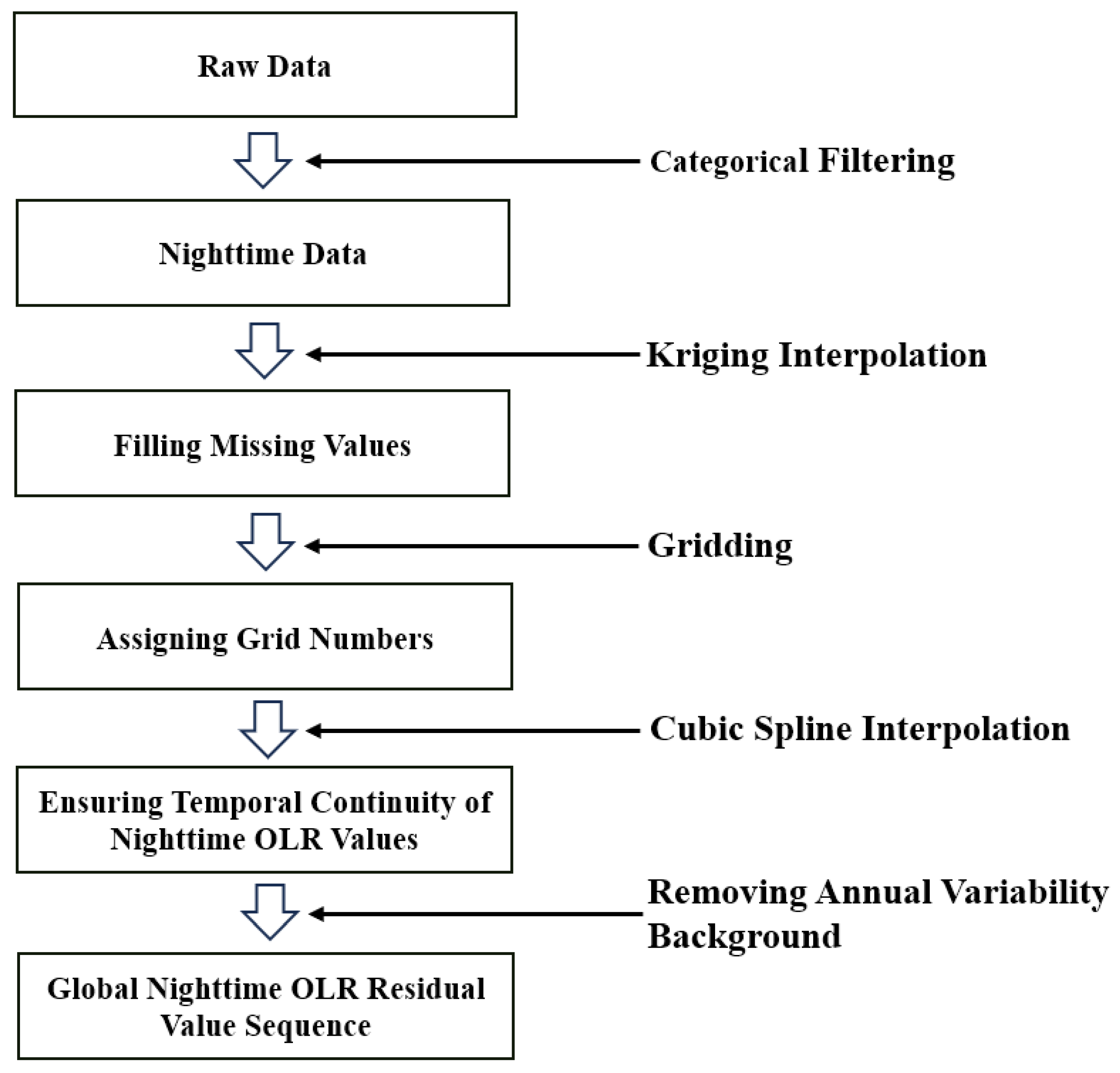
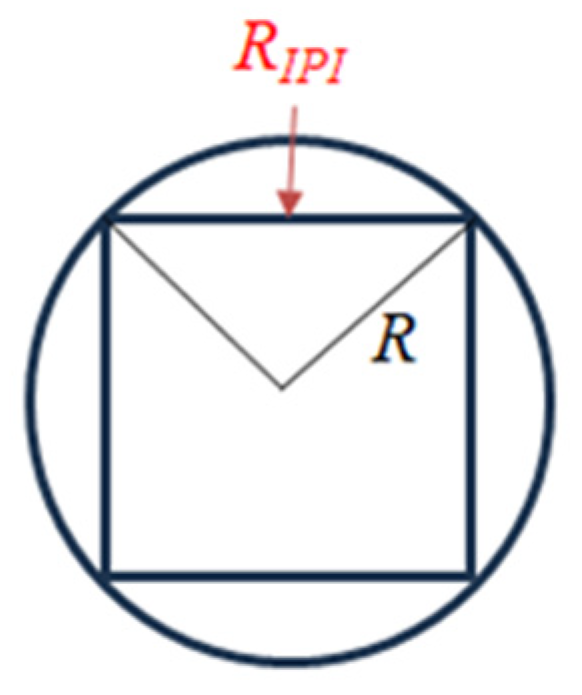

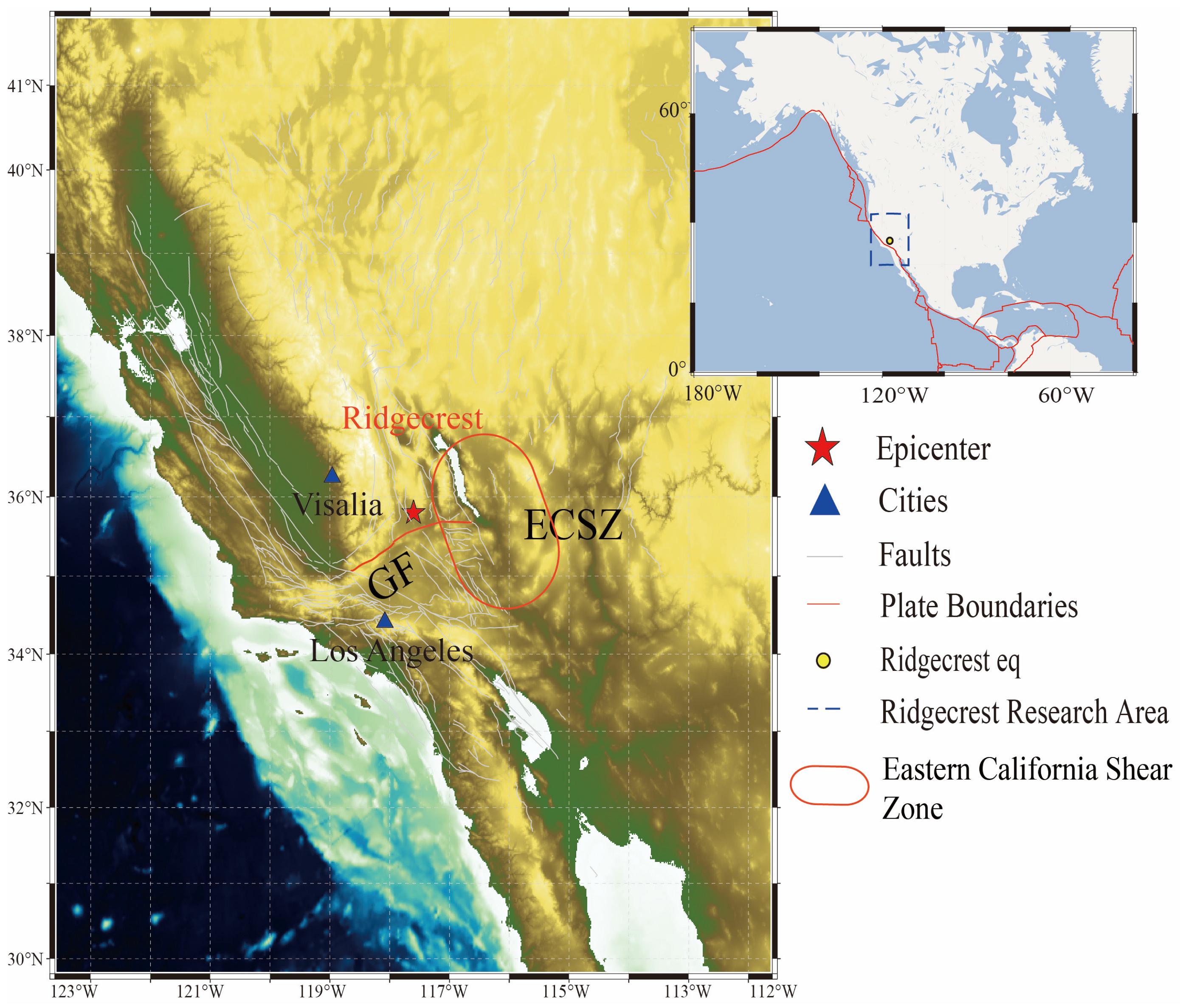
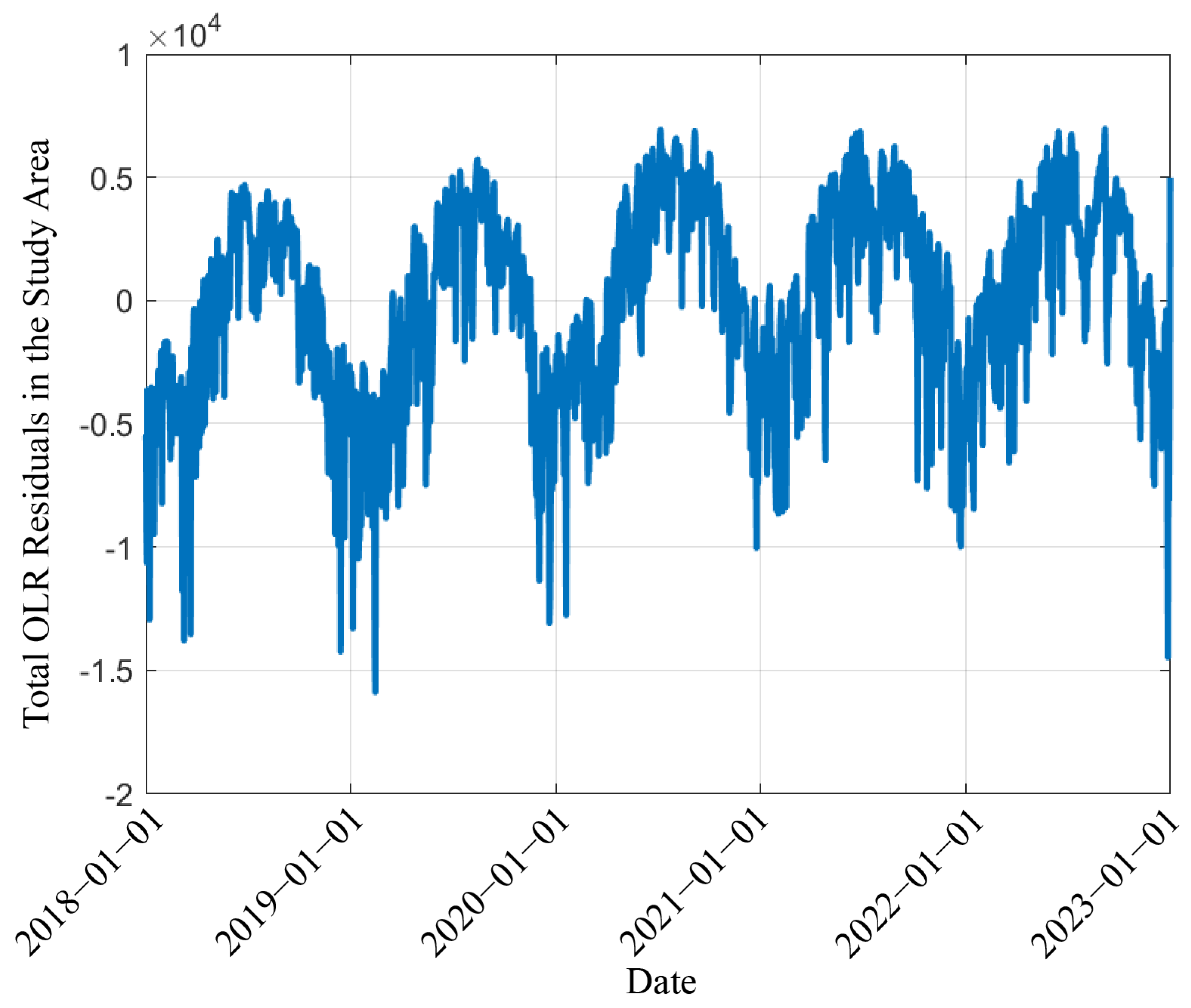
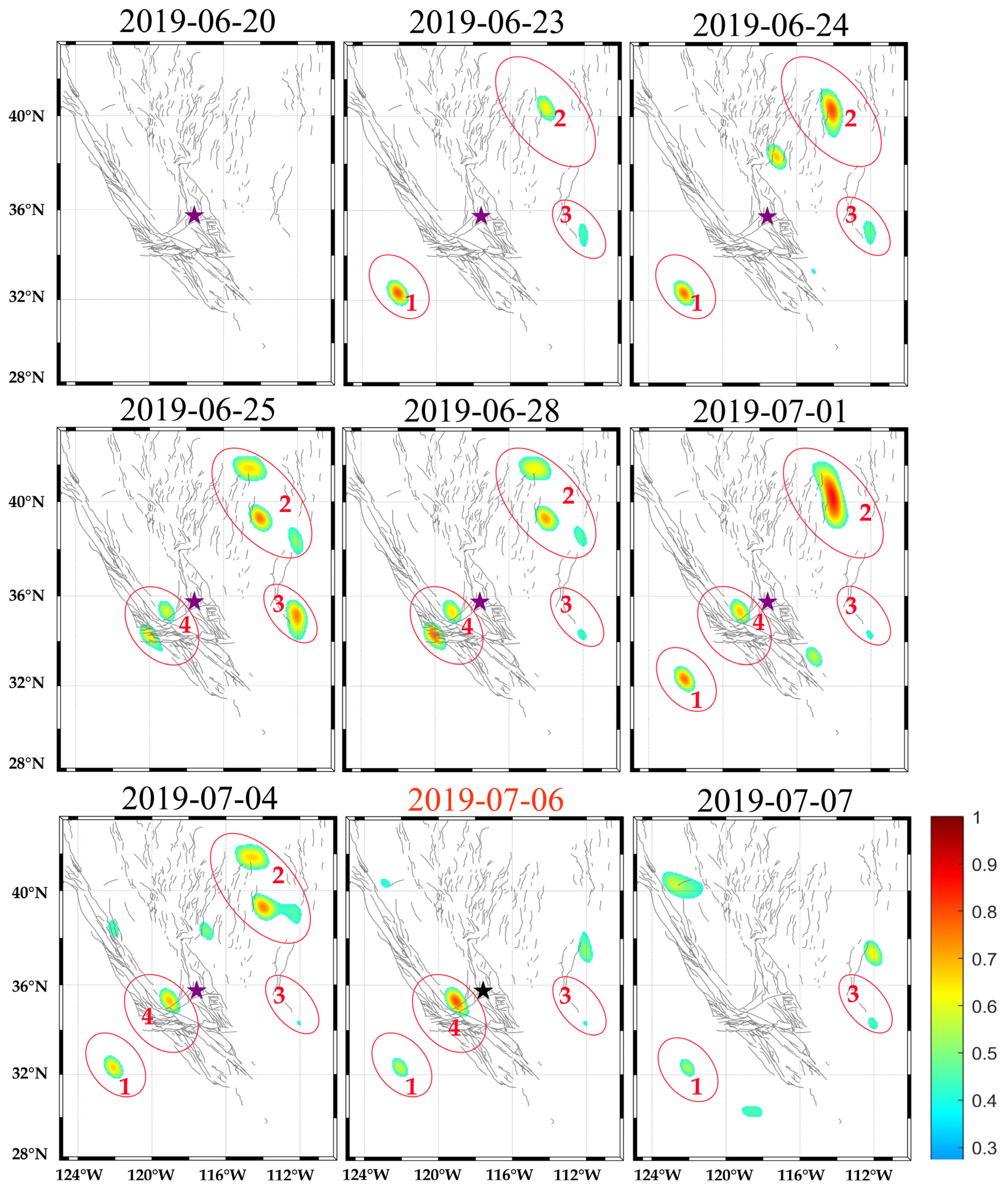


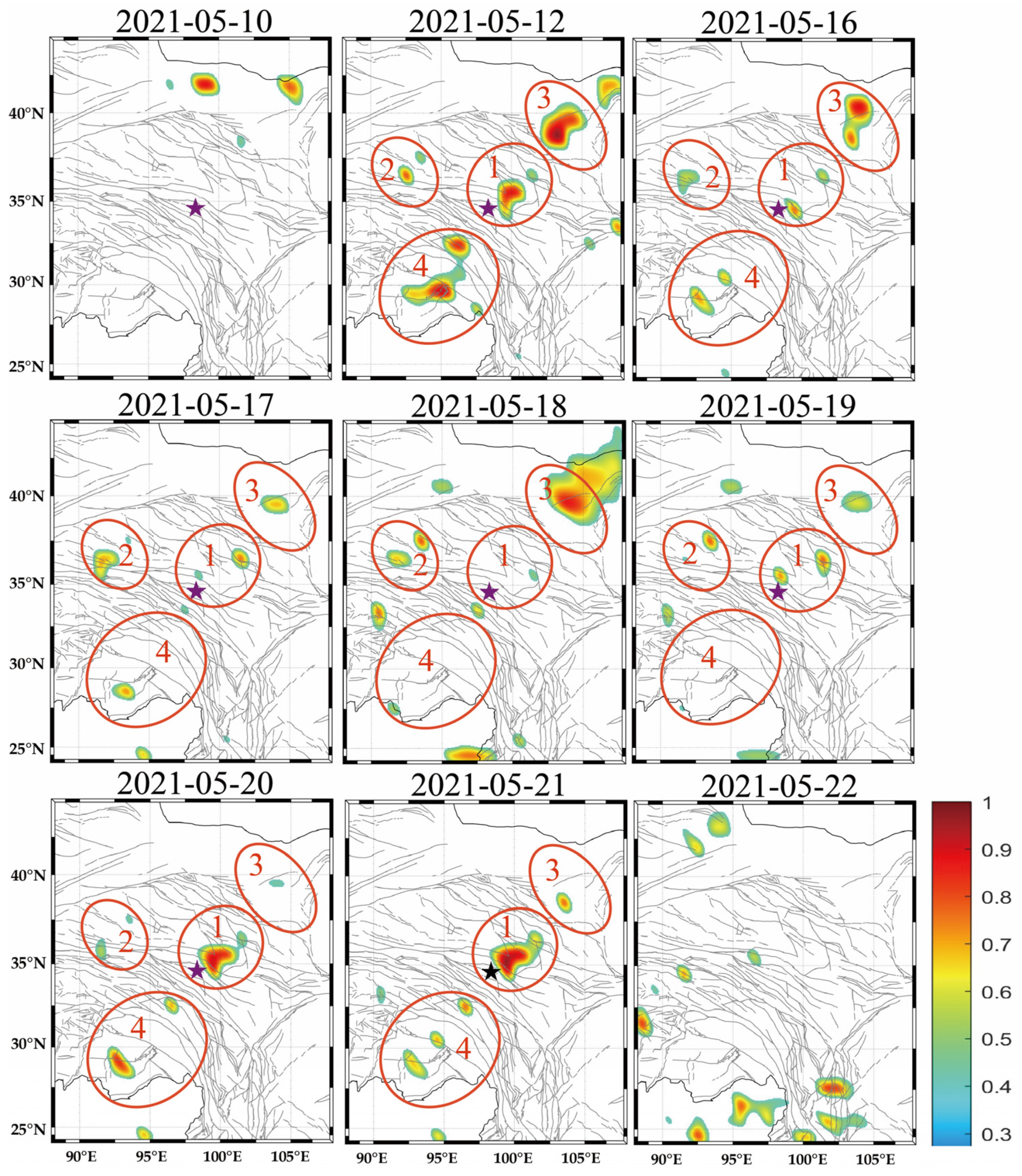

| Earthquake Event | Earthquake Types | Magnitude (CENC/USGS) | Longitude/E° (CENC/USGS) | Latitude/N° (CENC/USGS) |
|---|---|---|---|---|
| Ridgecrest earthquake, in the United States, on 6 July 2019 | Land–shallow-intraplate earthquake | Ms 6.9/Mw 7.1 | −117.58/−117.59 | 35.75/35.77 |
| Maduo earthquake, in China, on 21 May 2021 | Land–shallow-intraplate earthquake | Ms 7.4/Mw 7.3 | 98.34/98.25 | 34.59/34.59 |
| Model Number | Size of Study Area | Background Window Length (Months) | Learning Window Length (Days) |
|---|---|---|---|
| 1 | 12° × 12° | 12 | 10 |
| 2 | 12° × 12° | 12 | 20 |
| 3 | 12° × 12° | 12 | 30 |
| 4 | 12° × 12° | 12 | 40 |
| 5 | 12° × 12° | 12 | 50 |
| 6 | 12° × 12° | 12 | 60 |
| 7 | 12° × 12° | 12 | 70 |
| 8 | 12° × 12° | 12 | 80 |
| 9 | 12° × 12° | 12 | 90 |
| 10 | 12° × 12° | 12 | 100 |
| 11 | 12° × 12° | 12 | 110 |
| 12 | 12° × 12° | 12 | 120 |
| 13 | 12° × 12° | 12 | 130 |
| 14 | 12° × 12° | 12 | 140 |
| 15 | 12° × 12° | 12 | 150 |
| 16 | 12° × 12° | 12 | 160 |
| 17 | 12° × 12° | 12 | 170 |
| 18 | 12° × 12° | 12 | 180 |
| 19 | 12° × 12° | 12 | 101 |
| 20 | 12° × 12° | 12 | 102 |
| 21 | 12° × 12° | 12 | 103 |
| 22 | 12° × 12° | 12 | 104 |
| 23 | 12° × 12° | 12 | 105 |
| 24 | 12° × 12° | 12 | 106 |
| 25 | 12° × 12° | 12 | 107 |
| 26 | 12° × 12° | 12 | 108 |
| 27 | 12° × 12° | 12 | 109 |
| Anomaly Grouping | Distance from Epicenter (KM) (Approximate) | June | July | Lasting Time of Consistant Anomaly | |||||||||||||||
|---|---|---|---|---|---|---|---|---|---|---|---|---|---|---|---|---|---|---|---|
| 20 | 21 | 22 | 23 | 24 | 25 | 26 | 27 | 28 | 29 | 30 | 1 | 2 | 3 | 4 | 5 | 6 | |||
| 1 | 580 | √ | √ | √ | √ | √ | √ | √ | √ | √ | 7 | ||||||||
| 2 | 600 | √ | √ | √ | √ | √ | √ | √ | √ | √ | √ | √ | √ | 12 | |||||
| 3 | 670 | √ | √ | √ | √ | √ | √ | √ | √ | √ | √ | √ | √ | √ | √ | 14 | |||
| 4 | 200 | √ | √ | √ | √ | √ | √ | √ | √ | √ | √ | √ | √ | 12 | |||||
| Model Number | Size of Study Area | Background Window Length (Months) | Learning Window Length (Days) |
|---|---|---|---|
| 1 | 20° × 20° | 12 | 10 |
| 2 | 20° × 20° | 12 | 20 |
| 3 | 20° × 20° | 12 | 30 |
| 4 | 20° × 20° | 12 | 40 |
| 5 | 20° × 20° | 12 | 50 |
| 6 | 20° × 20° | 12 | 60 |
| 7 | 20° × 20° | 12 | 70 |
| 8 | 20° × 20° | 12 | 80 |
| 9 | 20° × 20° | 12 | 90 |
| 10 | 20° × 20° | 12 | 100 |
| 11 | 20° × 20° | 12 | 110 |
| 12 | 20° × 20° | 12 | 120 |
| 13 | 20° × 20° | 12 | 130 |
| 14 | 20° × 20° | 12 | 140 |
| 15 | 20° × 20° | 12 | 150 |
| 16 | 20° × 20° | 12 | 160 |
| 17 | 20° × 20° | 12 | 170 |
| 18 | 20° × 20° | 12 | 180 |
| 19 | 20° × 20° | 12 | 81 |
| 20 | 20° × 20° | 12 | 82 |
| 21 | 20° × 20° | 12 | 83 |
| 22 | 20° × 20° | 12 | 84 |
| 23 | 20° × 20° | 12 | 85 |
| 24 | 20° × 20° | 12 | 86 |
| 25 | 20° × 20° | 12 | 87 |
| 26 | 20° × 20° | 12 | 88 |
| 27 | 20° × 20° | 12 | 89 |
| Anomaly Grouping | Distance from Epicenter (KM) (Approximate) | May | Lasting Time of Consistent Anomaly | |||||||||||||
|---|---|---|---|---|---|---|---|---|---|---|---|---|---|---|---|---|
| 12 | 13 | 14 | 15 | 16 | 17 | 18 | 19 | 20 | 21 | |||||||
| 1 | 200 | √ | √ | √ | √ | √ | √ | √ | √ | √ | √ | 10 | ||||
| 2 | 700 | √ | √ | √ | √ | √ | √ | √ | √ | √ | 9 | |||||
| 3 | 850 | √ | √ | √ | √ | √ | √ | √ | √ | √ | √ | 10 | ||||
| 4 | 800 | √ | √ | √ | √ | √ | √ | √ | √ | √ | √ | 10 | ||||
| Earthquake | Earthquake Types | Magnitude (Ms) | Model Parameters | Pre-Earthquake Anomaly Characteristics | Anomalies Begin to Appear |
|---|---|---|---|---|---|
| Ridgecrest earthquake, United States, 6 July 2019 | Land–shallow-intraplate earthquake | 6.9 | 12-Month Background Window Length, 106-Day Learning Window Length | The anomaly lasted for 12 days until the day of the earthquake, disappearing afterward; spatially, it was located southwest of the epicenter near the fault, approximately 200 KM from the epicenter; morphologically, it exhibited consistency before and after, exhibiting a certain evolutionary trend. | 12 days before earthquake |
| Maduo earthquake, China, 21 May 2021 | Land–shallow-intraplate earthquake | 7.4 | 12-Month Background Window Length, 88-Day Learning Window Length | The anomaly lasted for 10 days until the day of the earthquake, disappearing afterward; spatially, it was located southwest of the epicenter near the fault, approximately 200 KM from the epicenter; morphologically, it exhibited consistency before and after, exhibiting a certain evolutionary trend. | 10 days before earthquake |
Disclaimer/Publisher’s Note: The statements, opinions and data contained in all publications are solely those of the individual author(s) and contributor(s) and not of MDPI and/or the editor(s). MDPI and/or the editor(s) disclaim responsibility for any injury to people or property resulting from any ideas, methods, instructions or products referred to in the content. |
© 2024 by the authors. Licensee MDPI, Basel, Switzerland. This article is an open access article distributed under the terms and conditions of the Creative Commons Attribution (CC BY) license (https://creativecommons.org/licenses/by/4.0/).
Share and Cite
Feng, M.; Xiong, P.; Tian, W.; Liu, Y.; Ju, C.; Song, C.; Zhang, Y. Modification of IPI Method for Extraction of Short-Term and Imminent OLR Anomalies and Case Study of Two Large Earthquakes. Geosciences 2024, 14, 325. https://doi.org/10.3390/geosciences14120325
Feng M, Xiong P, Tian W, Liu Y, Ju C, Song C, Zhang Y. Modification of IPI Method for Extraction of Short-Term and Imminent OLR Anomalies and Case Study of Two Large Earthquakes. Geosciences. 2024; 14(12):325. https://doi.org/10.3390/geosciences14120325
Chicago/Turabian StyleFeng, Maoning, Pan Xiong, Weixi Tian, Yue Liu, Changhui Ju, Cheng Song, and Yongxian Zhang. 2024. "Modification of IPI Method for Extraction of Short-Term and Imminent OLR Anomalies and Case Study of Two Large Earthquakes" Geosciences 14, no. 12: 325. https://doi.org/10.3390/geosciences14120325
APA StyleFeng, M., Xiong, P., Tian, W., Liu, Y., Ju, C., Song, C., & Zhang, Y. (2024). Modification of IPI Method for Extraction of Short-Term and Imminent OLR Anomalies and Case Study of Two Large Earthquakes. Geosciences, 14(12), 325. https://doi.org/10.3390/geosciences14120325







